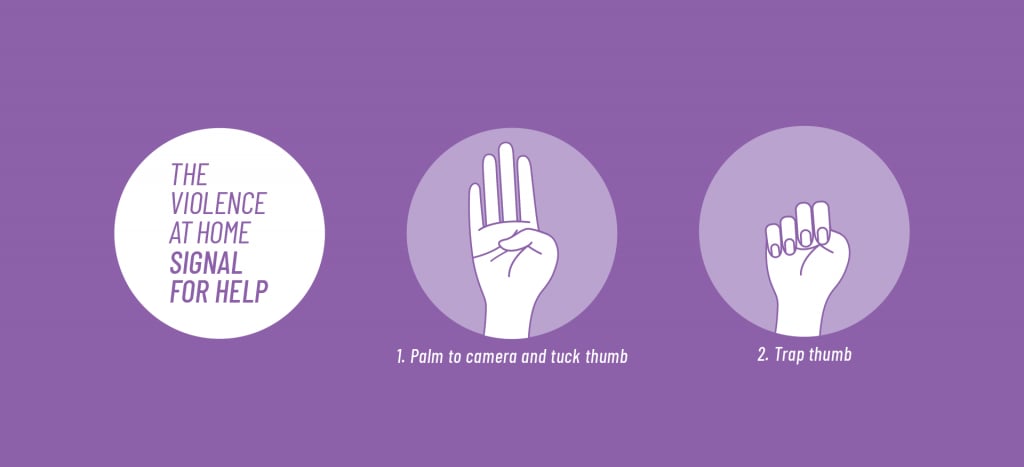Domestic violence is a serious global issue, and the problem may be getting worse for many families during the COVID-19 pandemic. Stay-at-home orders can make the act of escaping a violent partner or family member especially difficult, and many countries around the world are reporting a troubling increase in reports of domestic violence incidents. In an effort to combat the rise of domestic violence in their own country, the Canadian Women’s Foundation has launched a new initiative to give victims in need a way to silently and secretly ask for help. It’s called the Signal for Help, and it’s catching on in more places than just Canada.
The foundation’s Signal for Help is a simple hand gesture that can be done over Zoom calls, TikTok, FaceTime or any other type of video service. To make the signal, you hold up your open palm, tuck your thumb against it, and then close your fingers over your thumb.
When the signal is given, those on the receiving end should know to check on the victim discreetly and seek emergency help if needed. The Canadian Women’s Foundation recommends meeting in person or calling and asking “yes” or “no” questions (in case someone else is listening) or open-ended questions to help determine what the victim needs.
“There’s ample evidence that disaster situations often lead to a surge in violence that women, girls and trans and non-binary people are at highest risk of experiencing,” a press release states. “The Canadian Women’s Foundation is calling on other organizations to help spread awareness of Signal for Help. Their hope is that support services and organizations will encourage the use of this gesture to let women, girls and trans and non-binary people know that they don’t need to suffer in silence.”
Though the signal was launched in Canada, the campaign has been shared globally on social media. It’s also being promoted by the Women’s Funding Network, an alliance of more than 100 women’s foundations and funds spanning 14 countries.
In the U.S., nearly one in three women and one in four men have experienced intimate partner violence, according to the National Intimate Partner and Sexual Violence Survey by the Centers for Disease Control and Prevention (CDC). Sadly, this type of violence also impacts millions of children.
The U.S. Department of Health and Human Services reports that more than 15 million children live in a home in which domestic violence has happened at least once. Children who grow up in this environment and witness and/or experience abuse are at higher risk for:
-
Entering into abusive relationships.
-
Becoming abusers themselves.
-
Experiencing health problems, like depression and anxiety, as they get older.
Domestic violence is a huge problem, and obviously a hand signal is not a foolproof way to stop it. The Canadian Women’s Foundation acknowledges that the signal won’t be usable for all people. “We know that internet and video calling are not readily accessible to some,” says Paulette Senior, President and CEO of the Canadian Women’s Foundation. “Shelters and support services are doing everything they can to respond to the surge in violence. Signal for Help seeks to contribute to these efforts.”
Some are also expressing concern that advertising the signal on social media could tip off abusers and put victims at risk. “Sharing these signs on social media is the worst idea,” one user writes on Instagram. “I work with women who have experienced abuse, and the abuse only gets worse if they are caught trying to get help. This video is now readily available for the abuser to see. We need to find more discrete ways of passing messages like this on so the abuser won’t be able to find the signal.”
Others point out that social media may be the only way for some victims to learn about the signal, and even if it’s imperfect, it’s still a valuable option. “You can see from the video she’s doing it in such a way that only the caller on the other end can see it,” another user adds. “This will work for some people. Other things will work for other people. Many people in abusive relationships don’t have the luxury of professional [help], but do have friends and family.”
So, what do you do if you have a friend or loved one who needs help? According to the U.S. Department of Health and Human Services, you should:
-
Find a safe, private location to talk about what’s happening.
-
Avoid shaming or placing blame on the victim.
-
Help them create a safety plan.
-
Be supportive of their wants and needs, even if they aren’t ready to leave the relationship.
-
Find a domestic violence agency or other local resources for help.
If you or someone you know is at risk, you can also contact the National Domestic Violence Hotline at 800-799-SAFE (7233).




